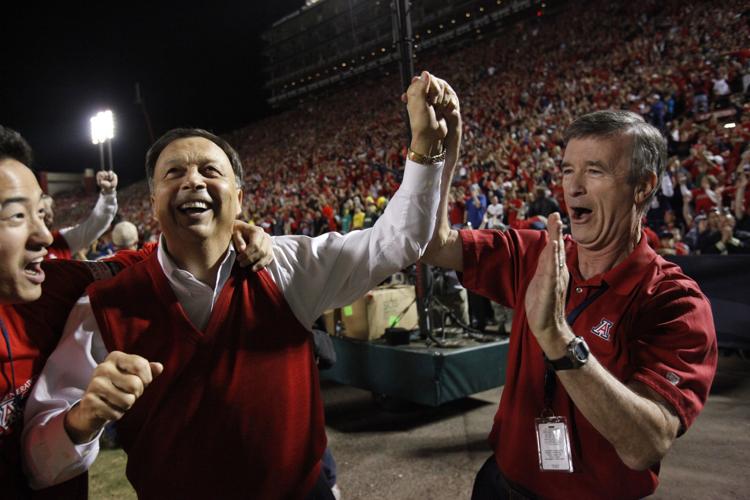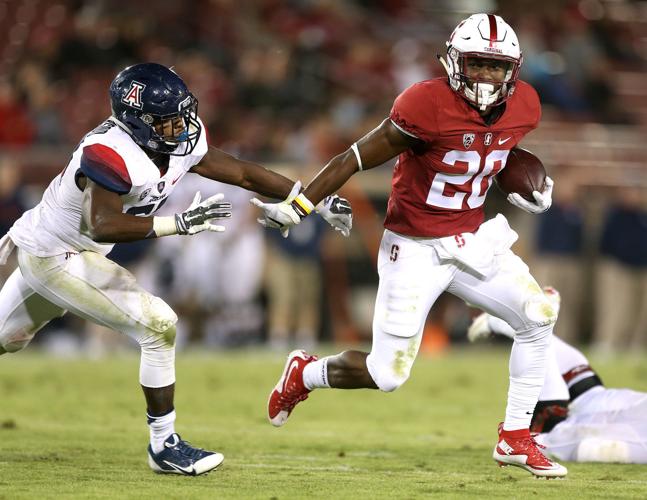The truth, the whole truth, half-truths, shades of the truth and other items admissible as sports news:
ITEM I: The ballot for the College Football Hall of Fame, 2021, has been released and it includes 13 former Pac-12 players, including Arizona State kicker Luis Zendejas and Sun Devil defensive aces Al Harris and David Fulcher.
No former Arizona Wildcats are on the ballot and that’s frustrating because seven ex-Wildcats are fully qualified and at least three have résumés that should be seriously considered. They are: kicker Steve McLaughlin, receiver-returner Dennis Northcutt and cornerback Antoine Cason.
The Southern Arizona Chapter of the National Football Foundation and College Hall of Fame was superb and effective in its advocacy of the four Wildcats inducted in the last 25 years: linebacker Ricky Hunley, pass rusher Tedy Bruschi, defensive lineman Rob Waldrop and safety Chuck Cecil. Having a local chapter actively promote a nominee is key. The three qualifications are as follows:
(1) Must have been a first-team All-American; (2) must have been out of college football for 10 years; (3) must have exhibited positive citizenship after playing football.
Unfortunately, two of the most notable All-Americans in UA history, defensive backs Darryll Lewis and Chris McAlister, experienced post-football off-field difficulties, which probably will keep both from being nominated.
The competition for induction is off-the-charts difficult. The new ballot includes those like USC’s Jack Del Rio, Cal’s Tony Gonzales and Stanford’s Ed McCaffrey. But my guess is that former Arizona running back Ka’Deem Carey will someday be a sure-thing once he becomes eligible for nomination in 2022.
ITEM II: In his 16 years as Arizona’s athletic director, Jim Livengood was a “we-not-me,” positive energy administrator who gained notable respect from his peers and in the Tucson community.
Last week, Livengood was named the 2020 winner of the James Corbett Award, the highest honor given each year by the National Association of Collegiate Athletic Directors (NACDA). Unfortunately, NACDA’s annual convention in Las Vegas was canceled by the coronavirus pandemic, and Livengood, who is retired and splitting time between homes in Tucson and Las Vegas, received his honor virtually instead of being applauded by about 400 of his peers.
Here’s an idea of how prestigious the Corbett award is: of the 54 NCAA administrators so honored, only seven were ADs in the Pac-12: Cedric Dempsey of Arizona, Jesse Hill of USC, Mike Lude and Barbara Hedges of Washington, Fred Miller and Gene Smith of ASU and Bill Byrne of Oregon.
Over those 54 years, there have been 73 athletic directors at Pac-12 schools, meaning that Livengood is in the top 10%.
“Nothing in intercollegiate athletics has a greater honor attached to it than the Corbett Award,” said Livengood. “For athletics leaders at any stage, there is no organization around that provides the leadership, education and family that NACDA provides.”
Well-deserved, for sure.
ITEM III: In a lengthy article in Sports Illustrated on Monday, the magazine suggested a total realignment of 120 college football teams into 10 regional leagues of 12 teams. It put Arizona in a Rocky Mountain conference with ASU, Colorado, Utah, BYU, Utah State, New Mexico, Boise State, Colorado State, Air Force, Wyoming and UNLV.
Chances of that coming to pass someday: 0.0000 percent.
The Arizona Board of Regents, as with their peers in Utah and Colorado, would never — ever — willingly separate from the academic prestige of Stanford, Cal, UCLA and USC and the media markets of Los Angeles, San Francisco and Seattle.
It would be financial suicide for a school like Arizona to play in a regional conference.
Next.
ITEM IV: The financial future of athletic departments at Arizona, ASU and in the Pac-12 are the subject of such speculation that now the Las Vegas oddsmakers are involved.
An online betting company — sportsbettingdime.com — is now taking bets on the possible decline in college football attendance for the 2020 season. It predicts that FBS schools will draw just 13.8 million fans this season — if there is a season — down from last year’s total attendance of 36.9 million.
It predicts Pac-12 attendance will bottom out at 11,980 per game; last year the Pac-12 had its smallest average attendance since 1981, averaging 47,467. That would be a reduction of about 70%.
Such a number would create a financial catastrophe at every school in the league, including Nike-blessed Oregon.
More troubling than a betting website forecasting financial doom for the Pac-12 is the attempt by Under Armour to withdraw from its apparel and marketing deals with UCLA and Cal. Under Armour released a statement saying it plans to separate from UCLA because it has been “paying for marketing benefits that we have not received for an extended period of time.”
In 2016, Under Armour puzzlingly agreed to pay UCLA $280 million over 15 years. It failed to grasp that UCLA’s status in the greater LA sports market is far below that of the Lakers, Dodgers, Angels, Clippers, Rams, Chargers and USC. Plus, the Bruins, much like Arizona State, have forever played the “sleeping giant” role, rarely reaching national prominence, a brand that has been stuck in neutral since John Wooden retired 45 years ago.
Simultaneous to Under Armour’s attempt to use an “act of god” clause to separate from UCLA, Nike was reported to have posted a net loss of $790 million in its latest quarterly earnings report. More than 40 FBS schools, including Arizona, are operating with significant Nike contracts.
Where does this stop? If apparel companies no longer see the benefits of paying millions to schools like Arizona, the salary structure of college sports will be rocked like never before.
And one more thing: Fox reportedly has withdrawn from its television coverage of the U.S. Open and other USGA events. Fox is the No. 2 source of media rights money to Pac-12 schools. If Fox is losing tens of millions of dollars covering golf’s leading events, imagine what its bottom line might look like when Pac-12 media rights contracts are up for bid/renewal in three years.
If the U.S. Open golf tournament is a financial loser, what’s the value of late-night Pac-12 football and basketball programming being viewed by small audiences in Tucson, Tempe and Berkeley, California?
No one can be certain what the sports TV economy will be like in 2023 or 2024, or how much longer Nike and Adidas will be willing to underwrite Pac-12 athletic departments who depend on apparel money to keep raising the salaries of their coaches and administrative staffs.
The long-term solutions of finances in college sports — how valuable college sports will be — will continue to be an issue long after a COVID-19 vaccine is discovered.






